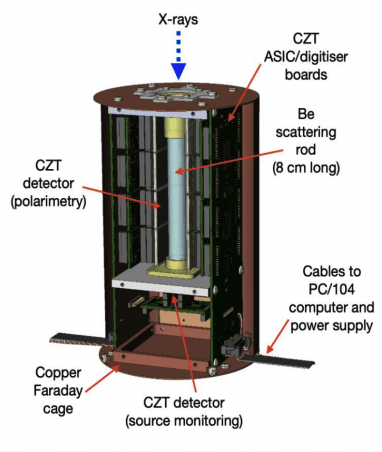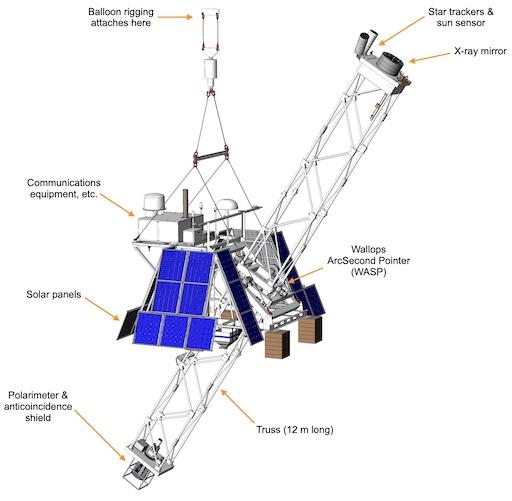About XL-Calibur
The XL-Calibur mission is a balloon-borne X-ray telescope planned to be launched from the Esrange Space Center near Kiruna, Sweden, and again from McMurdo Station in Antartica. The flight durations are 5–7 days from Sweden, and 5–55 days for the McMurdo flight. The balloon circles the polar region at stratospheric attitudes (roughly 40 km; 130,000 feet) where atmospheric attenuation of X-rays is diminished. A proof-of-concept mission, X-Calibur, was flown from McMurdo Station in Antarctica (29 Dec 2018 – 1 Jan 2019). X-Calibur was also flown in a test flight in September 2016 from Fort Sumner, New Mexico; no astrophysical data was collected in the New Mexico flight, but the instruments did characterize the high-altitude background noise environment. XL-Calibur uses a flight spare X-ray telescope from the Hitomi mission with a 12 m focal length, mounted in an optical bench truss: the X-Calibur Dec 2018 flight used the smaller InFOCμS mirror, which had a shorter 8 m focal length. The detector is sensitive to the linear polarization of hard X-rays, and is shielded from atmospheric gamma- and cosmic rays with anti-coincidence detectors. XL-Calibur is deployed on a gondola beneath the balloon, equipped with high-precision steering to control the orientation of the telescope. At the end the mission, the apparatus is parachuted back to the surface and recovered for reflight. The flight program has a modest list of proposed targets in the northern (Esrange) and southern (McMurdo) skies; The December 2018 X-Calibur flight observed GX 301-2 and Vela X-1, but was cut short when the balloon developed a leak. The gondola underneath the balloon is equipped with the Wallops Arc Second Pointer (WASP) which provides absolute orientation to 15 arcsec accurary, and pointing stability of less than 1 arcsec. An azimuth rotator provides coarse orientation of the entire gondola assembly, which the WASP system fine tunes as well as providing precise elevation control to the telescope assembly. The detector itself rotates around its optical axis once per minute in order to minimize systemic errors from small non-uniformities in the detector. Star trackers provide pointing information. XL-Calibur includes an off-axis star tracker (tilted at 25° from the pointing axis) which permits the instrument to be pointed at high elevations (i.e. through the balloon) or at targets blocked by stratospheric clouds. The system also includes a wide field-of-view sun sensor to enable absolute pointing information of targets close to the Sun. The telescope consists of an open truss made of lightweight carbon fibre tubes and aluminium connectors designed to meet NASA’s flight safety standard requirements of withstanding accelerations up to 16 g, which may be encountered when landing, and maintain integrity even when exposed to temperature extremes expected in the stratosphere. The X-ray mirror assembly is mounted on a honeycombed plate at one end of the bench; the detector assembly is mounted on a similar plate at the opposite end. 
X-rays are focused using a set of 213 nested conical shells nestled inside one another in a Wolter I grazing incidence configuration with a 12 m focal length: it uses the flight spare mirror for the Hard X-ray Telescope on Hitomi, minus the unnecessary pre-collimator (as the mission focuses on bright, not faint, sources, so stray light from adjacent bright sources is not a concern). The platinum-carbon multi-layer coatings on the mirror extends the energy range detectable to ∼80 keV (X-Calibur’s InFOCμS mirror with a different coating was limited to <60 keV): the very thin atmosphere at the 40 km flight altitude absorbs high-energy radiation <15 keV. The detector is a single beryllium rod, surrounded by Cadmium Zinc Telluride (CZT) detectors (2mm thick CZT in X-Calibur; 0.8 mm thick in XL-Calibur). A CZT detector array at the rear of the scattering rod is used to monitor the position of the source within the field of view. The detector is also equipped with Bismuth Germanium Oxide (Be4GO12; often shortened to BGO) anti-coincidence detectors to shield the instrument from background radiation interference. XL-Calibur has an angular resolution of ∼2 arcmin, an effective area of 180 cm2 at 30 keV, an energy resolution of ∼5.9 keV at 40 keV with ∼1 μs timing precision.
Latest NewsOct 2023New XL-Calibur launch windowThe new XL-Calibur launch window from Kiruna, Sweden, is set from May 7 to July 15 2024.
Oct 2022Update on the XL-Calibur Jul 2022 flightthe 6-day long flight had to contend with an accidental drop of the entire flight ballast at one side of the gondola, leading to 3.5 days of recovery operations without science observations. Furthermore, a mirror alignment error prevented the observations of the X-ray targets in the remaining time.
12 Jul 2022Successful XL-CALIBUR launchXL-CALIBUR was launched in the early morning hours of 12 July 2022 (local time) from Esrange under excellent launch conditions. The balloon carried the payload to 130,000 feet altitude until the mission was terminated over northern Canada on July 18, 2022.
30 Jun 2022XL-CALIBUR launch attempt #2XL-CALIBUR planned launch early 1 July 2022 scrubbed due to wind conditions. Next planned launch attempt 2 July 2022 (early morning local time)
24 Jun 2022XL-CALIBUR launch scrubbedThe payload was rigged for flight, but weather conditions prevented the planned launch.
|




